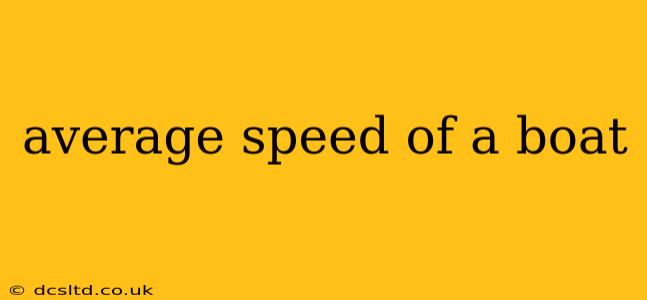Determining the average speed of a boat isn't as simple as looking at a speedometer. It depends on several crucial factors, making a single definitive answer impossible. This guide will explore these factors and provide a framework for understanding how to calculate and interpret a boat's average speed.
What Factors Influence a Boat's Speed?
Several elements significantly impact a boat's speed, making it challenging to give a single average. These include:
-
Boat Type: A small sailboat will have a drastically different speed potential than a powerful motorboat or a large cargo vessel. The hull design, length, and weight all play critical roles. A racing sailboat might achieve speeds exceeding 20 knots, while a fishing trawler might average only a few knots.
-
Engine Power (for motorized boats): The horsepower of the engine is a primary determinant of speed. More powerful engines generally translate to higher speeds. However, factors like propeller efficiency and hull design still play a part.
-
Water Conditions: Currents, waves, and wind significantly affect a boat's speed. A strong headwind can dramatically reduce speed, while a tailwind can increase it. Similarly, strong currents can either assist or impede progress. Choppy waters increase resistance, slowing the boat down.
-
Load: The weight onboard affects speed. A heavily loaded boat will be slower than one carrying a minimal load. This is especially crucial for smaller boats.
-
Hull Design: The shape and design of the hull are engineered to minimize resistance. A more hydrodynamic hull will achieve higher speeds for a given engine power.
How is a Boat's Speed Measured?
Speed is typically measured in knots (nautical miles per hour) at sea. GPS devices and onboard speedometers are commonly used. However, these readings represent instantaneous speed, not an average over a journey. To find the average speed, you need to consider the total distance covered and the total time taken.
How to Calculate Average Boat Speed
The calculation is straightforward:
Average Speed = Total Distance / Total Time
For example, if a boat travels 50 nautical miles in 5 hours, its average speed is 10 knots (50 miles / 5 hours). Remember that the distance should be in nautical miles and the time in hours for the result to be in knots.
H2: What is the average speed of a powerboat?
The average speed of a powerboat is highly variable and depends on the factors listed above. Small powerboats might average 15-25 knots, while larger, more powerful boats could reach 30 knots or more. Luxury yachts and high-performance boats can significantly exceed these speeds.
H2: What is the average speed of a sailboat?
Sailboat speeds are even more variable, as they're highly dependent on wind conditions. In favorable winds, a sailboat might achieve 6-8 knots, but in light winds, the speed could drop to just a few knots, or even zero. Racing sailboats in optimal conditions can reach much higher speeds.
H2: What affects the speed of a boat in the water?
As discussed earlier, several factors affect a boat's speed, including boat type, engine power (for motorized boats), water conditions (currents, waves, wind), load, and hull design. Each of these elements plays a critical role in determining how fast a boat can travel.
H2: How do you calculate the average speed of a boat?
Calculating average boat speed involves dividing the total distance traveled (in nautical miles) by the total time taken (in hours). The result is expressed in knots (nautical miles per hour).
In conclusion, there's no single "average speed of a boat." The speed varies dramatically based on numerous factors. Understanding these factors allows for a more nuanced appreciation of how boat speed is determined and calculated. Always prioritize safety and awareness of surrounding conditions when operating a boat.
